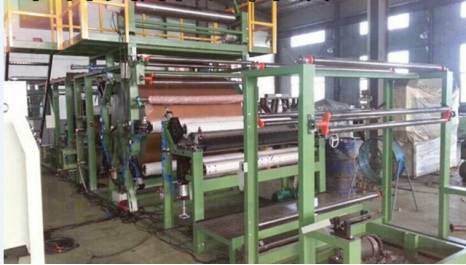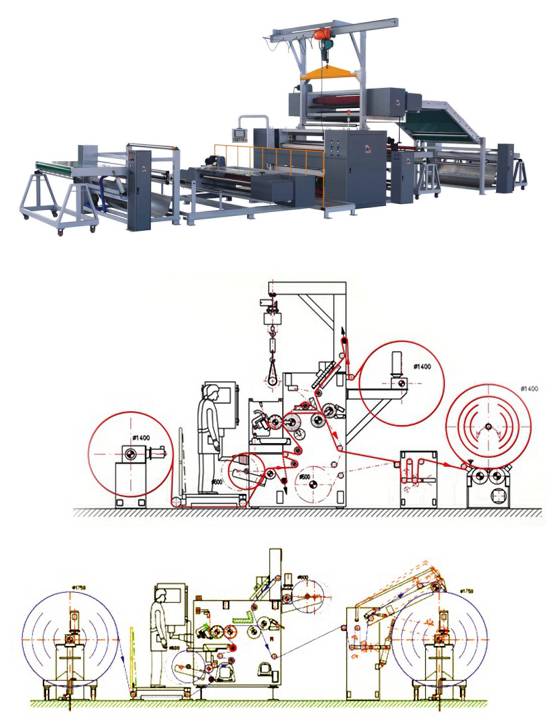Composite fabric
Overview: It is a new type of material made by using one or more layers of textile materials laminated by oil glue or hot melt glue.
International popular 6 kinds of composite fabric process
1
Heat-soluble adhesive powder coating composite fabric process
2
Hot-soluble glue point composite fabric process★that is, PUR
3
Heat-soluble glue powder coating laminated fabric process
4
Hot-soluble double-dot laminated fabric process
5
Polyurethane spraying composite fabric process
6
Polyurethane roll coating composite fabric process★that is, PU
Divided according to the number of layers.
Three layers: plus film composite; two layers: not plus film composite
Production principle
The core components of the compounding equipment are the gluing device and the compounding device. When the fabric (film) passes through the gluing device, the glue in the eye of the engraving roller is forced to transfer to the fabric (film) through the squeezing of the gluing roller, and then it is pressed together by the laminating device to get the initial bonding fastness.
Production flow
Gluing device
An engraving roller and a gluing silicone roller are used.
There are two general shapes of the engraving rollers: diamond-shaped dots and round dots.
The diamond-shaped point is arranged regularly, the point is consistent, and the performance of water pressure resistance is relatively good. There are two kinds of round dots: regular and irregular, with inconsistent point distance and relatively weak water pressure resistance.
Maintenance treatment
The time of maintenance treatment has a great influence on the fastness of fabric bonding and the degree of adhesive fusion. The maintenance treatment workshop is fully enclosed and the temperature and humidity are kept in the room to allow the natural fusion of adhesives. become hard.
PU process equipment
Traditional compounding equipment, the original glue is heated and dissolved in the solvent, manually added to the glue application tank, after compounding the big wheel hot press evaporate solvent.
The maturation condition of the glue is 30℃×5day, so that the solvent can be evaporated greatly.
Advantages and disadvantages of PU process.
Advantages
1、Low cost, flexible and convenient operation
Disadvantages
1、Solvent is pungent and unfriendly, easy to produce APEO and formaldehyde
2、Manual application is easy to mix with impurities, the amount of glue with the glue is not stable
3、The amount of glue applied is more, and the handfeel is hard.
4、The garment can not be dry-cleaned
★This process has more problems, if not chemical fiber fabric is recommended not to use this process
PUR process equipment

The use of solid content 100% single-component reactive hot melt adhesive, no chemical solvents, environmental protection, no irritating odor, automatic application of the machine, glue tank heating.
The maturation condition of hot melt adhesive is 30℃ room temperature, humidity﹥90%, and placed for 72 hours to achieve the final peeling effect.
Advantages and disadvantages of PUR process.
Advantages
1、Environmental protection, no odor, no formaldehyde
2, reactive glue, glue point lasting, garments can be dry-cleaned.
3、The amount of glue is small and soft to the touch
Disadvantages
1、The quality of glue is very important
2, the amount of glue is small, if the maintenance is not sufficient, the peeling strength is poor
Common problems of composite fabrics

1. Fabric color
1, the composite process of gluing, hot pressing, drying and other processes have an impact on the color of the fabric.
2, the surface fabric light color, the bottom cloth dark color, color superimposed on the bottom cloth color will have a greater impact on the color of the surface cloth.
2. Washing off / blistering
After compounding the fabric due to poor lamination fastness, when washed, the phenomenon of local unraveling or blistering.
3. Folding and wrinkling
Non-stretch thin fabric for the surface cloth, the base cloth knitting thicker, easy to occur when folding out the phenomenon of wrinkling.
4. Washing bark wrinkle
Surface cloth and bottom cloth shrinkage difference is greater than 3 points and the fabric thickness difference between the composite fabric will produce due to shrinkage differences in thin fabric surface formation bark wrinkle effect.
5. Rubber permeability
Woven fabric species light color system, fabric species thin, glue ripening after the surface of the fabric can be seen glue dots.
6. Overflow glue
The organization is sparse, the feel is hard, the glue seeps out of the cloth easily.
7. Light-colored fabric color yarn due to compound highlighting
White fabric, especially white tweed material, after compounding due to the backing of the base cloth leads to white fabric color yarn and other fabric defects are particularly prominent.
8. Composite entrapped foreign matter
PU compound production process compound glue easy to fly into the impurities (such as hair, fiber shavings and other impurities), compound light-colored fabrics when the entrapped foreign matter will appear on the surface of the cloth.
9. rolled edge
Elastic fabric and non-elastic fabric laminated and elastic fabric thickness than non-elastic fabric thick, in the composite production process, if the fabric tension control is not good is very easy to roll the edge phenomenon.
Summary and measures
Face and backing fabric selection
Good: the same width, the same shrinkage rate, the same thickness
1. The difference in shrinkage is greater than 3 points, the shrinkage rate of small fabric selection to be thicker than the shrinkage rate of the fabric (specific samples to determine).
2. Compound front material should not do hydrophobic soft treatment especially can not do the waterproof treatment containing fluorine.
3. Try to avoid choosing white fabric, especially white tweed to do composite
4. High-value fabrics should be narrower than low-value fabrics, and the difference in width should not be more than 10CM, otherwise the waste is larger.
5. Try not to choose fabrics with production risk to do compounding.
Compounding process
1. For fabrics that require dry-cleaning for garments, choose PUR process for compounding.
2. When compounding, the fabric should be aligned with the silk skein to avoid weft slanting, straight silk twisting, etc.
3. Medium-term maintenance treatment should be sufficient, otherwise the peeling strength is poor.
4. Compound processing seems to be simple, but the experience, technology and operation proficiency of the compounding factory have a lot to do with it.
5. After compounding, the fabric cannot be compounded again, even if peeled, it will affect the fabric yarn, feel hard and yarn is easy to be pierced by needle.
6. Non-elastic high-density woven fabric needs to be compounded with film, otherwise the fastness is poor
Compounding order process
1. Compound production should be assessed - sample - test to confirm
2. First cut pieces of composite large goods to change the fabric composite must be after a fabric sample evaluation to determine
3. Compound fabric national standard only FZ/T 72016-2012 "knitted composite taking fabric" applies to knitted fabric and other materials by the bonding composite process of garment fabrics.
4. Require 5 times of washing without stripping, no blistering, peel strength qualified
Contact: Jeanne yang(MISS)
Phone: 13912652341
E-mail: [email protected]
Add: Room A2216/A2217,Double-Star Building,No 567 New South Middle Road, KunShan City JiangSu Province ,China.